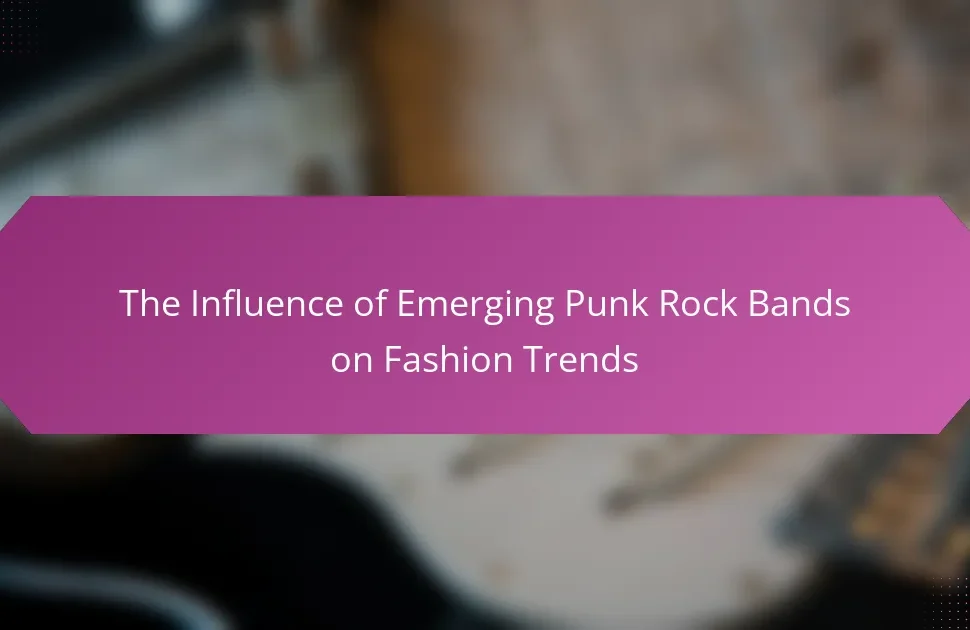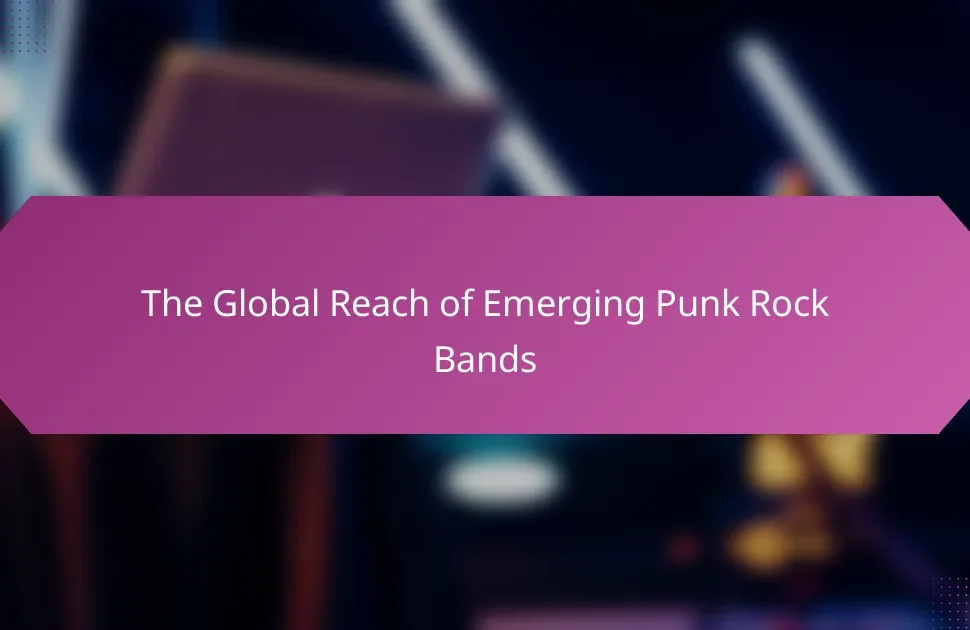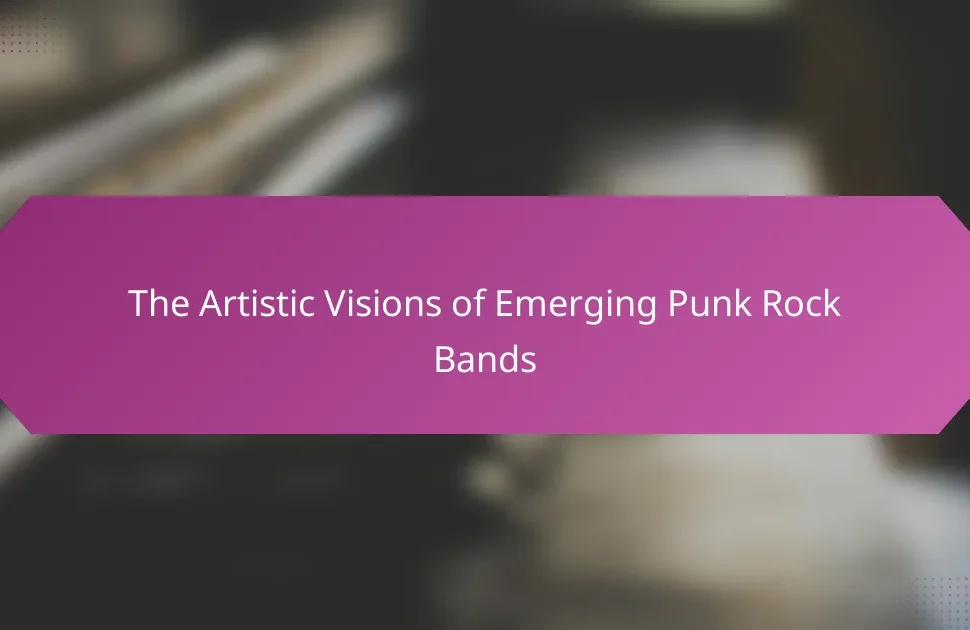Collaborations between emerging punk rock bands and established artists offer significant benefits, including increased exposure and creative innovation. These partnerships can enhance visibility for new bands and refresh the sound of seasoned artists. However, challenges such as power dynamics and creative differences must be navigated. Social media platforms like Instagram and TikTok play a crucial role in showcasing these collaborations, fostering connections and audience engagement.
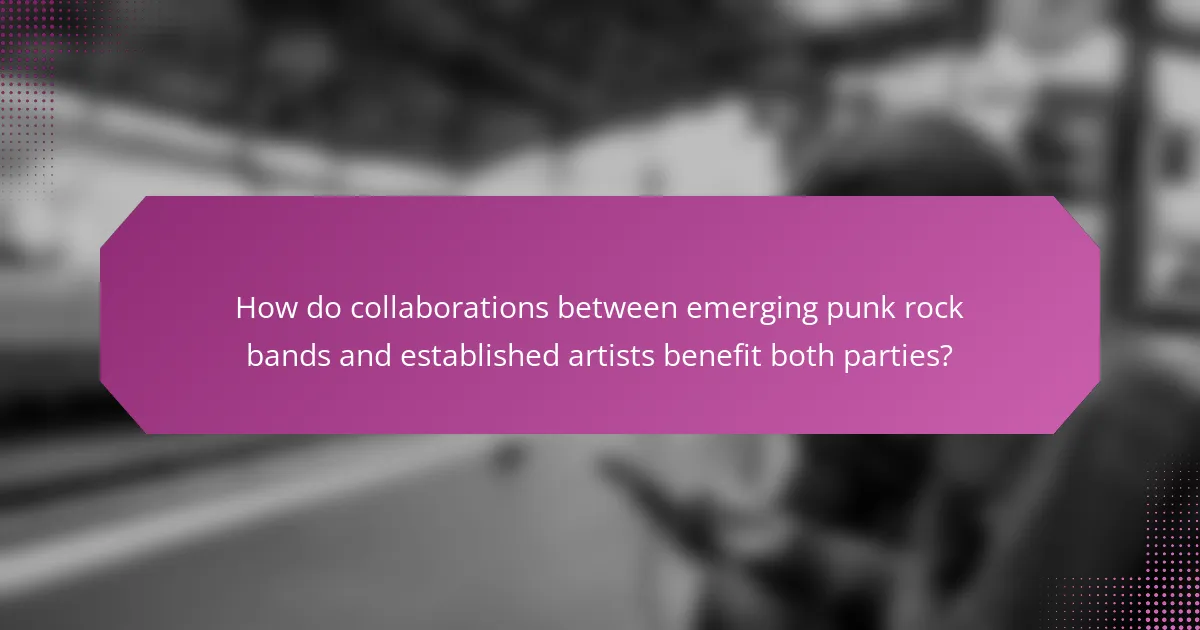
How do collaborations between emerging punk rock bands and established artists benefit both parties?
Collaborations between emerging punk rock bands and established artists create mutual benefits. Emerging bands gain exposure, mentorship, and credibility, while established artists refresh their sound and connect with younger audiences.
Emerging bands often struggle with visibility. Collaborating with established artists can introduce them to wider audiences, enhancing their reach. Established artists benefit from the fresh energy and innovative ideas that emerging bands bring, allowing them to stay relevant in the evolving music scene.
Additionally, collaborations can lead to unique sound fusions. This creative synergy often results in innovative music that appeals to diverse fan bases, enhancing the artistic value for both parties. Such partnerships can also create memorable live performances, attracting larger crowds and generating buzz.
Overall, these collaborations foster a dynamic exchange of creativity, resources, and audience engagement, making them advantageous for both emerging and established punk rock artists.
What are the key motivations for established artists to collaborate with emerging bands?
Established artists collaborate with emerging punk rock bands to revitalize their sound, reach new audiences, and foster creativity. Collaborations allow established artists to tap into fresh perspectives and innovative styles, enhancing their musical repertoire. For emerging bands, partnering with seasoned artists offers credibility, exposure, and valuable mentorship. This symbiotic relationship can lead to unique projects that blend experience with youthful energy, ultimately benefiting both parties. Additionally, collaborations can generate buzz within the music community, attracting attention to both established and emerging artists.
How do emerging punk rock bands gain exposure through these collaborations?
Emerging punk rock bands gain exposure through collaborations with established artists by leveraging their fan bases and credibility. These partnerships often lead to increased visibility and access to larger audiences. Collaborations can include co-writing songs, joint tours, or featured appearances on tracks. Such exposure enhances the band’s reputation and can result in more media coverage and promotional opportunities. Additionally, the unique attributes of each band can create fresh sounds that attract attention, making these partnerships mutually beneficial.
What unique opportunities arise from blending different musical styles?
Blending different musical styles creates unique opportunities for collaboration, innovation, and audience expansion. Emerging punk rock bands can gain exposure by working with established artists, leveraging their fan bases. This fusion leads to fresh sounds, attracting diverse listeners and enhancing creative expression. Collaborations often result in unique tracks that showcase the strengths of both parties, pushing genre boundaries. Additionally, these partnerships can foster mentorship, providing emerging artists with valuable industry insights and experience.
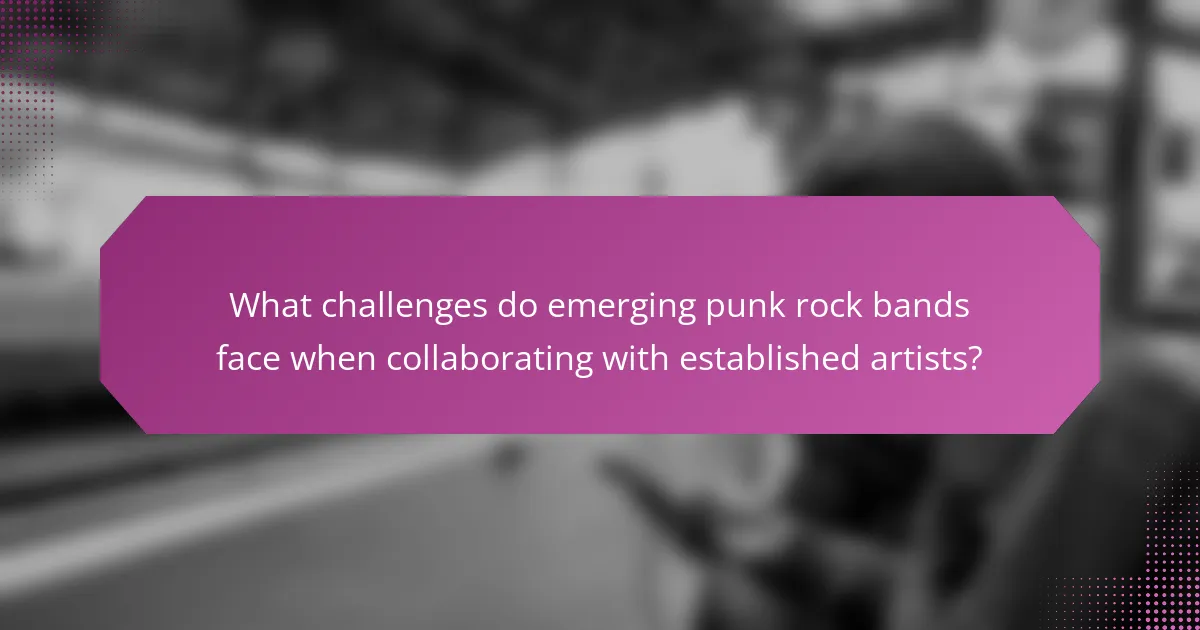
What challenges do emerging punk rock bands face when collaborating with established artists?
Emerging punk rock bands face significant challenges when collaborating with established artists. These include navigating power dynamics, managing creative differences, and overcoming industry gatekeeping.
Established artists often hold more influence, which can lead to imbalances in collaboration. This power dynamic may restrict the creative freedom of emerging bands. Creative differences can arise from contrasting artistic visions, making it essential for both parties to find common ground.
Additionally, established artists may have preconceived notions about the emerging scene, leading to potential misunderstandings. Emerging bands must also contend with the music industry’s gatekeeping, which can hinder access to established artists.
Ultimately, successful collaboration requires clear communication, mutual respect, and a willingness to compromise.
How do differences in creative vision impact collaboration?
Differences in creative vision can significantly enhance collaboration between emerging punk rock bands and established artists. Emerging bands often bring fresh perspectives and innovative ideas, while established artists contribute experience and a well-defined sound.
This dynamic can lead to unique musical fusions, where the raw energy of new talent meets the polished skills of seasoned musicians. For instance, collaborations can result in genre-blending tracks that attract diverse audiences.
Additionally, differing visions encourage experimentation, pushing both parties to explore uncharted territories in their music. Such collaborations can also foster mentorship, where established artists guide emerging bands, enriching their creative process.
Overall, the interplay of varying creative visions not only benefits the artists involved but also enhances the punk rock genre by introducing new influences and styles.
What are the financial implications of these partnerships?
The financial implications of partnerships between emerging punk rock bands and established artists can be significant. These collaborations often lead to increased exposure and revenue opportunities for both parties.
Emerging bands gain access to established fan bases, enhancing their visibility and potential sales. Established artists benefit from fresh creativity and can rejuvenate their brand appeal.
Additionally, joint tours and merchandise can create new revenue streams. For example, shared concert revenues can be more profitable than solo performances.
Overall, these partnerships can result in mutually beneficial financial outcomes, driving growth in the punk rock genre.
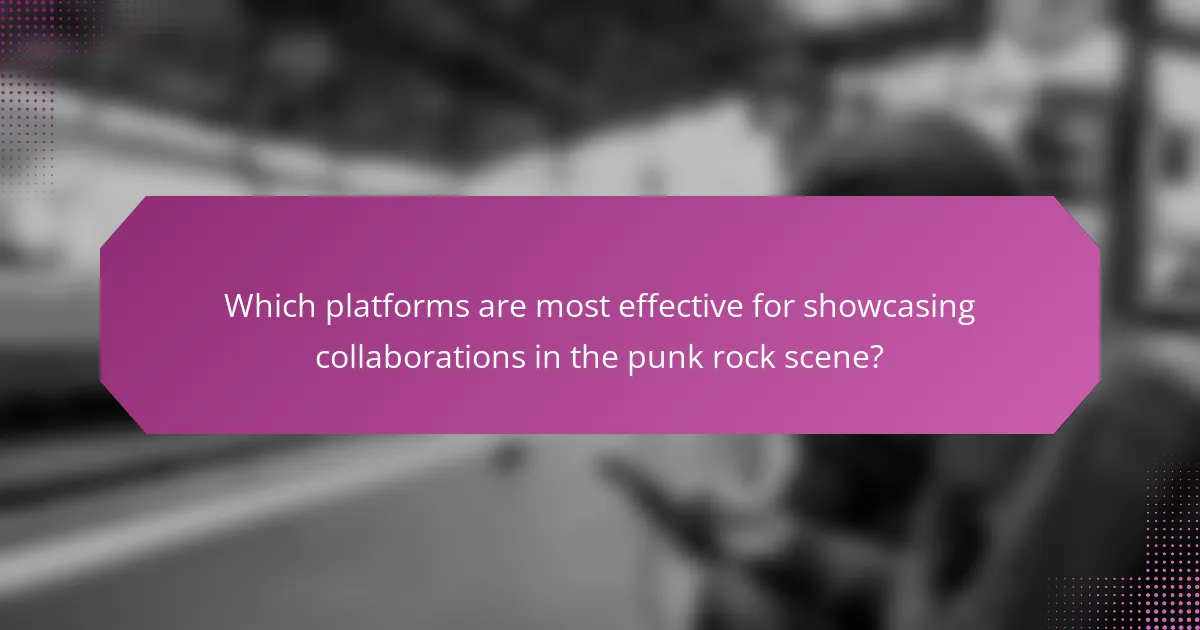
Which platforms are most effective for showcasing collaborations in the punk rock scene?
Social media platforms like Instagram and TikTok are most effective for showcasing collaborations in the punk rock scene. These platforms allow bands to share visual content and engage directly with fans. Instagram’s emphasis on imagery highlights dynamic collaborations, while TikTok’s short videos can create viral moments, boosting visibility. Additionally, YouTube serves as a valuable platform for longer-form content, showcasing music videos and behind-the-scenes footage of collaborations. Each platform’s unique features cater to different aspects of punk rock culture, fostering connections between emerging bands and established artists.
How do social media strategies differ between emerging and established artists?
Emerging punk rock bands often focus on grassroots engagement, while established artists leverage broader platforms. Emerging artists utilize social media to build community and showcase raw talent, engaging directly with fans. Established artists, in contrast, often use polished content and strategic partnerships to amplify their reach. Collaborations between these groups can blend authenticity with marketability, benefiting both parties. Emerging bands gain exposure, while established artists tap into fresh creativity. The unique attributes of their fan bases can create rare opportunities for innovative content and cross-promotion.
What role do live performances play in promoting collaborative work?
Live performances significantly enhance collaboration between emerging punk rock bands and established artists. These events provide a platform for networking, creativity, and shared audiences. Emerging bands gain exposure and mentorship, while established artists can revitalize their sound and connect with new fans. As a result, collaborations often lead to innovative music that blends different styles and perspectives. Live shows foster a unique environment where spontaneity and artistic synergy thrive, creating memorable experiences for both artists and audiences.

What are notable examples of successful collaborations between emerging punk rock bands and established artists?
Notable collaborations between emerging punk rock bands and established artists include instances that amplify creativity and reach. One significant example is the partnership between the band PUP and punk legend Dave Grohl, which resulted in a powerful track that showcased both their styles. Another noteworthy collaboration is between the rising band The Interrupters and Tim Armstrong of Rancid, blending their sounds and expanding their audience. These partnerships often lead to unique musical fusions, enhancing the punk rock genre. Such collaborations highlight the mutual benefits of sharing experience and innovation in music.
How did these collaborations influence the careers of the emerging bands?
Collaborations between emerging punk rock bands and established artists significantly boost visibility and credibility. These partnerships often lead to increased fan engagement and access to larger platforms. Emerging bands gain exposure through established artists’ fanbases, enhancing their growth potential. For instance, collaborations can result in shared tours or promotional opportunities, which amplify their reach. This synergy often accelerates the career trajectory of new bands, helping them establish a foothold in the competitive music industry.
What lessons can be learned from these successful partnerships?
Successful partnerships between emerging punk rock bands and established artists teach valuable lessons in collaboration, creativity, and audience engagement. These collaborations amplify exposure for new bands while enhancing the established artists’ relevance.
One key lesson is the power of mentorship. Established artists can guide emerging bands, sharing industry insights and helping them navigate challenges. This relationship fosters growth and innovation, allowing both parties to experiment with new sounds.
Another important lesson is the importance of authenticity. Successful collaborations maintain the unique identities of both artists, blending styles without compromising their core values. This authenticity resonates with audiences, creating a deeper connection.
Finally, leveraging social media is crucial. Collaborations can generate buzz and reach wider audiences, as fans of both artists engage with the new material. This strategy enhances visibility and strengthens community ties within the punk rock scene.
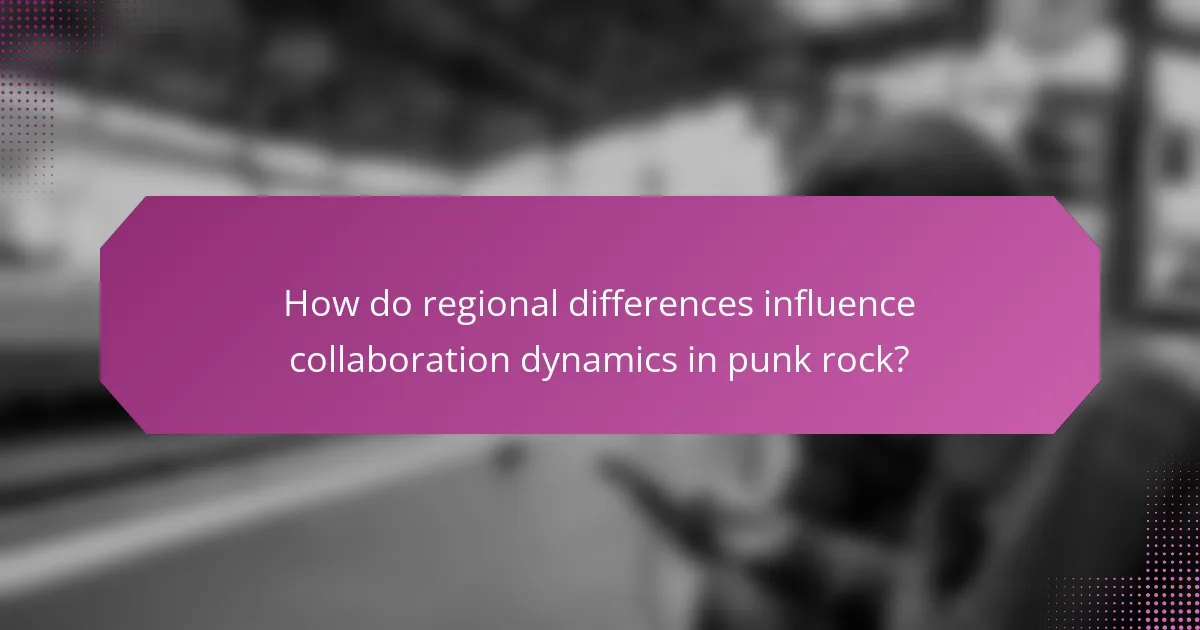
How do regional differences influence collaboration dynamics in punk rock?
Regional differences significantly shape collaboration dynamics in punk rock by influencing the cultural context and audience expectations. For instance, bands from urban areas often adopt a more aggressive style, while those from rural regions may focus on storytelling. This variance creates unique opportunities for partnerships, as emerging bands can learn from established artists who have navigated different regional challenges.
Collaborations can also reflect local issues, with artists addressing community struggles or celebrating regional pride. The fusion of diverse influences enriches the punk rock genre, allowing for innovative sounds and themes. Furthermore, established artists may seek collaborations with emerging bands to tap into fresh perspectives and connect with younger audiences, enhancing their relevance in the evolving music landscape.
In summary, regional differences foster unique collaboration dynamics, driving creativity and cultural exchange in the punk rock scene.
What are the cultural factors affecting punk rock collaborations in different regions?
Cultural factors such as regional influences, historical contexts, and local music scenes significantly affect punk rock collaborations. Emerging punk rock bands often draw inspiration from established artists, creating unique blends of styles that reflect their cultural backgrounds.
For instance, in the UK, the punk scene is deeply rooted in socio-political movements, leading to collaborations that emphasize activism. In contrast, bands in the U.S. may prioritize individualism and experimentation, fostering a different collaborative spirit.
Additionally, local music festivals and community events play a crucial role in facilitating these partnerships. They provide platforms for emerging artists to connect with established musicians, leading to innovative collaborations that resonate with local audiences.
Furthermore, cultural acceptance and diversity influence the dynamics of these collaborations. Regions with a rich tapestry of cultural influences often see more diverse and experimental punk rock fusions, enhancing the genre’s evolution.
How do local scenes impact the opportunities for emerging bands?
Local scenes significantly enhance opportunities for emerging bands by fostering collaboration with established artists. These connections provide exposure and mentorship, allowing new acts to grow their audience and refine their craft.
Emerging punk rock bands benefit from established networks, gaining access to venues and promotional channels. Collaborations often lead to joint performances, which can attract diverse crowds and increase visibility.
Local scenes also create a supportive environment where emerging bands can experiment and receive immediate feedback. This interaction cultivates unique sounds and styles that resonate within the community.
In summary, the collaboration between emerging punk rock bands and established artists within local scenes is vital for growth, visibility, and artistic development.
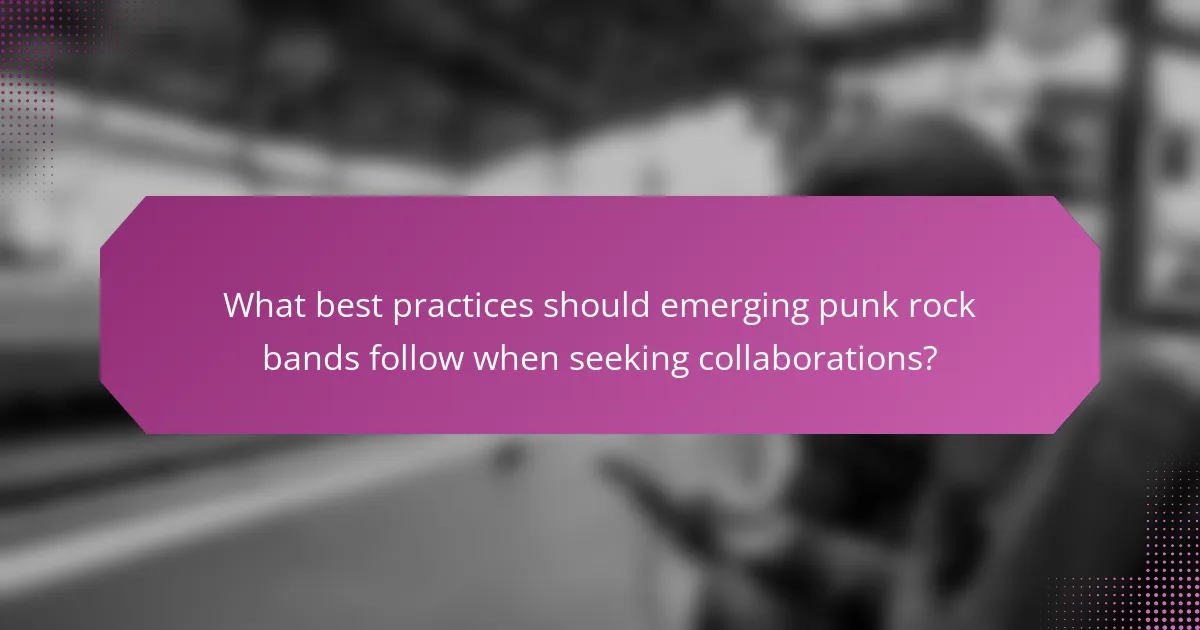
What best practices should emerging punk rock bands follow when seeking collaborations?
Emerging punk rock bands should prioritize authentic connections and mutual respect when seeking collaborations. Building relationships with established artists can enhance visibility and credibility.
1. Research potential collaborators to ensure alignment in style and values.
2. Approach artists with a clear vision of the collaboration’s benefits for both parties.
3. Utilize social media to engage with established artists and showcase your work.
4. Attend industry events to network and foster personal connections.
5. Be open to feedback and flexible in collaboration ideas to create a win-win scenario.
How can emerging bands effectively pitch their ideas to established artists?
Emerging bands can effectively pitch their ideas to established artists by focusing on authenticity and shared values. They should research the established artist’s work to align their proposal with the artist’s style and message. Personalizing communication enhances connection, making the pitch memorable. Demonstrating a unique sound or perspective can capture attention, while showcasing past achievements can build credibility. Networking at industry events allows for organic relationships, increasing the chances of collaboration.
What common mistakes should emerging bands avoid in collaborative efforts?
Emerging punk rock bands should avoid miscommunication, lack of creative input, and failing to establish clear roles. These mistakes can hinder collaboration and stifle artistic expression.
First, miscommunication can lead to misunderstandings about artistic direction, resulting in frustration. Clear dialogue ensures that all parties share the same vision.
Second, under-contributing to the creative process can diminish a band’s unique voice. Emerging artists should assert their ideas to maintain authenticity while blending influences from established artists.
Lastly, not defining roles within the collaboration can create confusion. Each member should understand their responsibilities to maximize productivity and artistic synergy.

